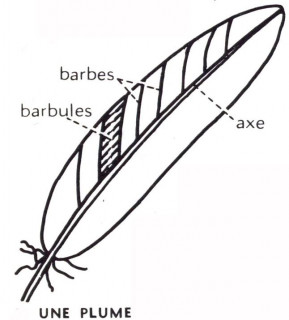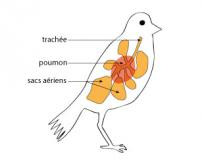The flight of birds
Of all the species groups, only birds, insects, and bats are capable of active flight. What adaptations allow birds to fly?
Wings :
Wings represent the primary adaptation of birds to flight. The bird's wing is a forelimb, built on the same plane as that of other vertebrates, whose skeleton is covered by a skin with feathers. Today, birds are the only animals that have feathers.
The function of the wing is both to counterbalance gravity (thanks to its aerodynamic shape) and to propel the animal's body (thanks to the highly developed pectoral muscles that ensure the wing beats).
Other parts of the body play an important role in flight, such as the tail, which can act as a rudder, parachute and brake.
Bird's wing and aircraft wing
Birds' and aircraft's wings share some common characteristics.
The upper surface of an aircraft wing is convex, while the inner surface is concave. The front of the wing, the "leading edge", is thicker than the back of the wing, the "trailing edge". These characteristics create a zone of underpressure underneath the wing, making it easier to fly. Engineers have relied on the aerodynamic laws that apply to bird wings to build and launch aircraft.
Wings :
Just like our nails and hair, feathers are made of a protein called keratin. A feather is composed of barbs filled with barbules (lamellae that connect the barbs together), some of which are held together by small hooks called barbicles. This structure makes the feathers impermeable to water and air and insulates the animal thermally. Sometimes, the bird smoothes its feathers with its beak to ensure that the barbicels are attached to each other in order to maintain the waterproofness of its plumage.
Each feather is fixed in the skin by the calamus.
The legs of the birds, devoid of feathers, are the only parts of the body allowing them to evacuate the important heat which they produce during the flight.
Feathers with multiple functions
Bird feathers are not only used for flight, they also have other functions:
Communicating :
- With noises
By vibrating the air between their feathers, birds can produce sounds such as buzzing, whistling or snapping.
- By visual signals
The colour and pattern of the feathers are also used to communicate with other birds. For example, the robin shows its aggressiveness by displaying its orange breast. In spring, during the mating season, the feathers are renewed and their colour is revived in order to seduce a potential mate.
Protecting yourself
- Bad weather
In winter you can see that birds are plumper than in the summer. This is not only because they eat more, but also because their feathers (down on their backs, bellies and under their wings) swell up. The air trapped between the feathers warms up when it comes into contact with the skin (the body temperature of birds is 38-42°C depending on the species) and forms a protective layer against the cold. Another technique to combat low temperatures: birds tuck their heads and feet under their feathers.
To keep the plumage in good condition, the feathers are covered with a natural coating of fat and wax, a secretion produced by the uropygial gland at the base of the tail. When birds preen their feathers, they pick up this secretion with their beaks and deposit it on their feathers.
- Wind and sun
The feathers are overlapping and interlocking like tiles on a roof. The barbules and hooks form a seamless protective surface. The dark colours protect the bird's skin from the sun's rays.
Feeding yourself :
Barbless feathers (also called vibrissae) around the beak allow insectivorous birds that hunt in flight, such as the Grey Flycatcher, to smell their prey.
Building a nest :
Many birds use their feathers, which they mix with various elements such as straw, grass or twigs.
Deep breathing
In birds, the trachea-bronchus-lung assembly is not a closed system. The bronchioles are replaced by thin, parallel tubes (called parabronchial tubes) that run through the lungs and extend into air sacs. The lungs are small and rigid. During breathing, the rib cage does not move, which reinforces the stability of the bird during flight.
Breathing in birds takes place in 2 simultaneous cycles:
- Inspiration: The air sacs expand, air from outside is delivered to the posterior air sacs (not directly into the lungs as in humans). At the same time, the air already in the lungs is sent to the front air sacs.
- Exhalation : the air sacs deflate. The air in the front air sacs is expelled from the body while the air in the back air sacs is pushed towards the lungs where exchanges with the blood can take place.
The air therefore circulates in the lungs continuously and the supply of oxygen in the blood is never interrupted.
Bones not so light!
Most bird bones are hollow and related to the respiratory system. However, these bones are no lighter than those of mammals of the same mass. This is what Elizabeth R. Dumont has shown that the bones of birds, closely followed by those of bats, are denser than those of other mammals. This increase in bone density maximises the strength and rigidity of bones while minimising their mass and volume. This adaptation would make it easier for birds to fly. His results were published in the Proceedings of the Royal Society B.


